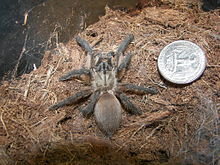| Eumenophorinae | |
|---|---|

| |
| Monocentropus balfouri | |
| Scientific classification | |
| Domain: | Eukaryota |
| Kingdom: | Animalia |
| Phylum: | Arthropoda |
| Subphylum: | Chelicerata |
| Class: | Arachnida |
| Order: | Araneae |
| Infraorder: | Mygalomorphae |
| Family: | Theraphosidae |
| Subfamily: | Eumenophorinae Pocock, 1897 |
| Genera | |
|
See text. | |
The Eumenophorinae are a subfamily of tarantula spiders (family Theraphosidae). They are known from genera distributed across Sub-Saharan Africa, the south of the Arabian peninsula, Madagascar and its associated islands, and parts of India.
Distribution
At about 158-160 million years ago (Mya), Gondwana split up and the Indo-Madagascan plate drifted away from the rest of the super continent. At around 84-86 Mya, India split from Madagascar and drifted into Eurasia (66-55 Mya), to its current position. Therefore, all fauna in Gondwana (such as the Eumenophorinae) would be distributed on all three land masses.
Characteristics
The Eumenophorinae have stridulatory spike setae on the coxae of all legs, and a "comb" of stiffened setae on the palpal femur. In 2005, Richard Gallon described the monotypic genus Mascaraneus, which lacks the stridulatory spike setae.
Taxonomy
The monophyly of the Eumenophorinae has been confirmed in a number of molecular phylogenetic studies. However, these have included relatively few of the genera that have been placed in the subfamily at one time or another. A 2014 study included Anoploscelus and Phoneyusa. A 2018 study included Hysterocrates, Monocentropus and Pelinobius.
Genera
Genera that have been placed in the subfamily Eumenophorinae by various sources include:
- Annandaliella Hirst, 1909
- Anoploscelus Pocock, 1897
- Batesiella Pocock, 1903
- Encyocrates Simon, 1892
- Eumenophorus Pocock, 1897
- Heterophrictus Pocock, 1900
- Heteroscodra Pocock, 1900
- Hysterocrates Simon, 1892
- Loxomphalia Simon, 1889
- Loxoptygus Simon, 1903
- Mascaraneus Gallon, 2005
- Monocentropus Pocock, 1897
- Myostola Simon, 1903
- Neoheterophrictus Siliwal & Raven, 2012
- Pelinobius Karsch, 1885 (as Citharischius Pocock, 1900)
- Phoneyusa Karsch, 1884
- Plesiophrictus Pocock, 1899
- Sahydroaraneus Mirza & Sanap, 2014
- Stromatopelma Karsch, 1881
References
- ^ Raven, R.J. (1985). "The spider infraorder Mygalomorphae (Araneae): Cladistics and systematics". Bulletin of the American Museum of Natural History. 182: 1–180. hdl:2246/955.
- ^ Mirza, Z.A.; Sanap, R.V. & Bhosale, H. (2014). "Preliminary review of Indian Eumenophorinae (Araneae: Theraphosidae) with description of a new genus and five new species from the Western Ghats". PLOS ONE. 9 (2): e87928. Bibcode:2014PLoSO...987928M. doi:10.1371/journal.pone.0087928. PMC 3925112. PMID 24551072.
- Guadanucci, J.P.L. (2014). "Theraphosidae phylogeny: relationships of the 'Ischnocolinae' genera (Araneae, Mygalomorphae)". Zoologica Scripta. 43 (5): 508–518. doi:10.1111/zsc.12065. S2CID 86484123.
- ^ Lüddecke, Tim; Krehenwinkel, Henrik; Canning, Gregory; Glaw, Frank; Longhorne, Stuart J.; Tänzler, René; Wendt, Ingo & Vences, Miguel (2018). "Discovering the silk road: Nuclear and mitochondrial sequence data resolve the phylogenetic relationships among theraphosid spider subfamilies". Molecular Phylogenetics and Evolution. 119: 63–70. Bibcode:2018MolPE.119...63L. doi:10.1016/j.ympev.2017.10.015. PMID 29104141.
- ^ Schmidt, G. (2003). "8.6 Eumenophorinae Pocock, 1897". Die Vogelspinnen: Eine weltweite Übersicht. Neue Brehm-Bücherei. Hohenwarsleben: Westarp Wissenschaften. pp. 207–216. ISBN 978-3-89432-899-3.
- Gallon, R.C. (2005). "On a new genus and species of theraphosid spider from Serpent Island, Mauritius (Araneae, Theraphosidae, Eumenophorinae)" (PDF). Bulletin of the British Arachnological Society. 13: 175–178. Archived from the original (PDF) on 2016-03-03. Retrieved 2016-02-07.
| Taxon identifiers | |
|---|---|
| Eumenophorinae |
|